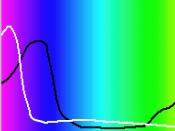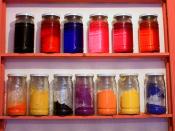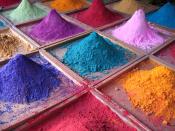Abstract
This experiment focused on extracting and separating pigments of Chloroplast. For the procedure green leaves were grinded in a mortar with some chemicals and the fluid was filtrated to use for further analysis. Stripes of this solution were put on a filter paper and later, after dried placed into a beacon of solvent. After this the chloroplast pigments were separated by the solvent into groups of more or less soluble pigments.
Aim
How many pigment types are present in a green leaf?
It is hoped to be able to identify the four different pigments types of a leaf. As the filter paper with the solvent will separate the pigments in terms of solubility, a clear segmentation of each is expected to show off.
As various chemicals were used in the whole process of this lab, certain variables might have influenced the results in terms of the purity of each chemical or purity of the used filtrate.
Background
The chloroplast, basically, is the organelle responsible for photosynthesis. Structurally it is very similar to the mitochondrion. It contains a permeable outer membrane, a less permeable inner membrane, a intermembrane space, and an inner section called the stroma. However, the chloroplast is larger than the mitochondria. It needs to have the larger size because its membrane is not folded into cristae. Also the inner membrane is not used for the electron transport chain. Instead it contains the light-absorbing system, the electron transport chain, and ATP synthetase in a third membrane that forms a series of flattened discs, called the thylakoids.
Materials required
Materials list
Test tubes, Water, small beacon, Pipette, Stand, Mortar, green leaves, Filter paper, capillary tube, funnel, silicon dioxide, calcium carbonate, acetone, solvent.
Method
1) To extract pigments from green Leaves
- Weigh 5g green Leaves, cut into pieces,


